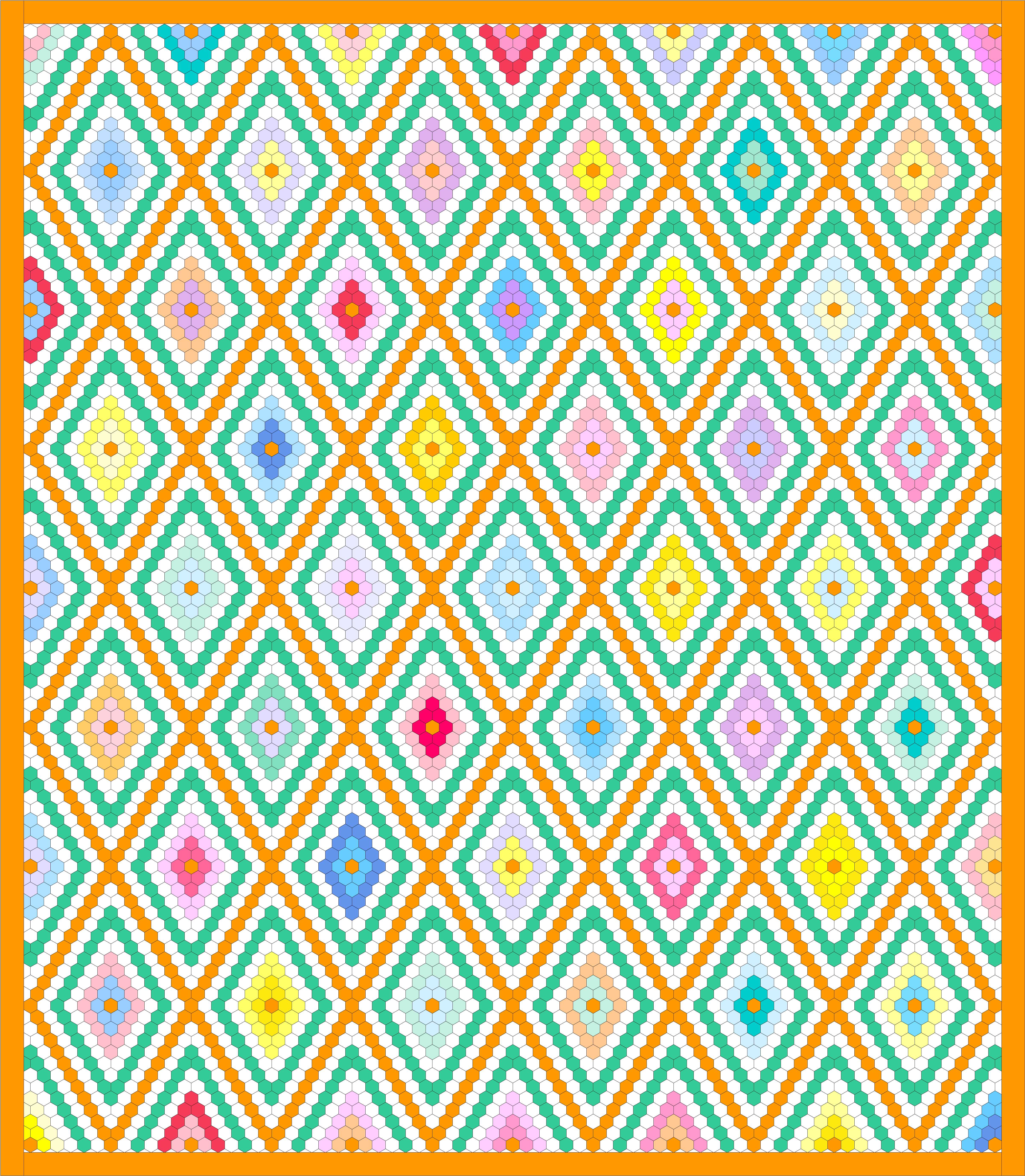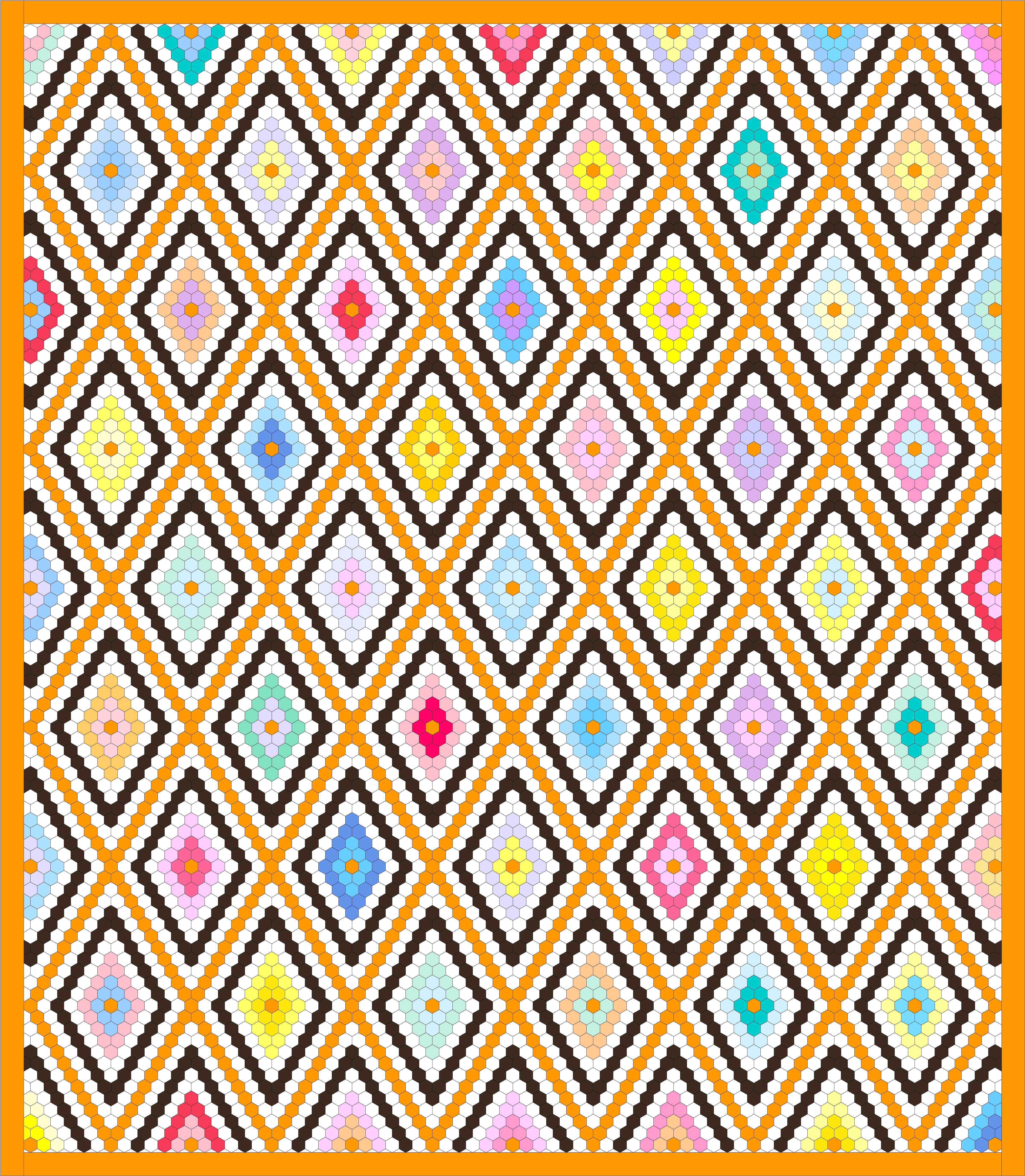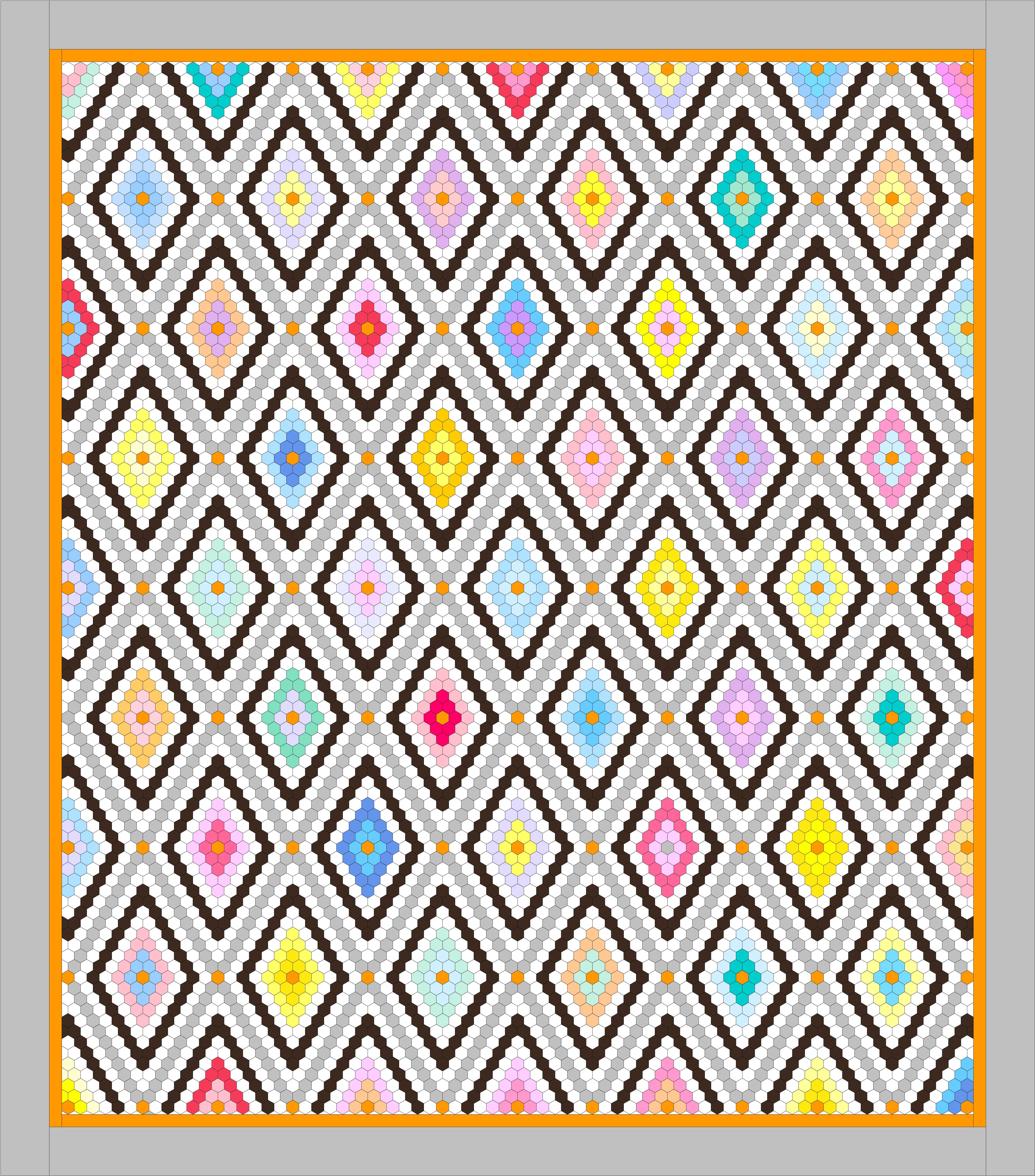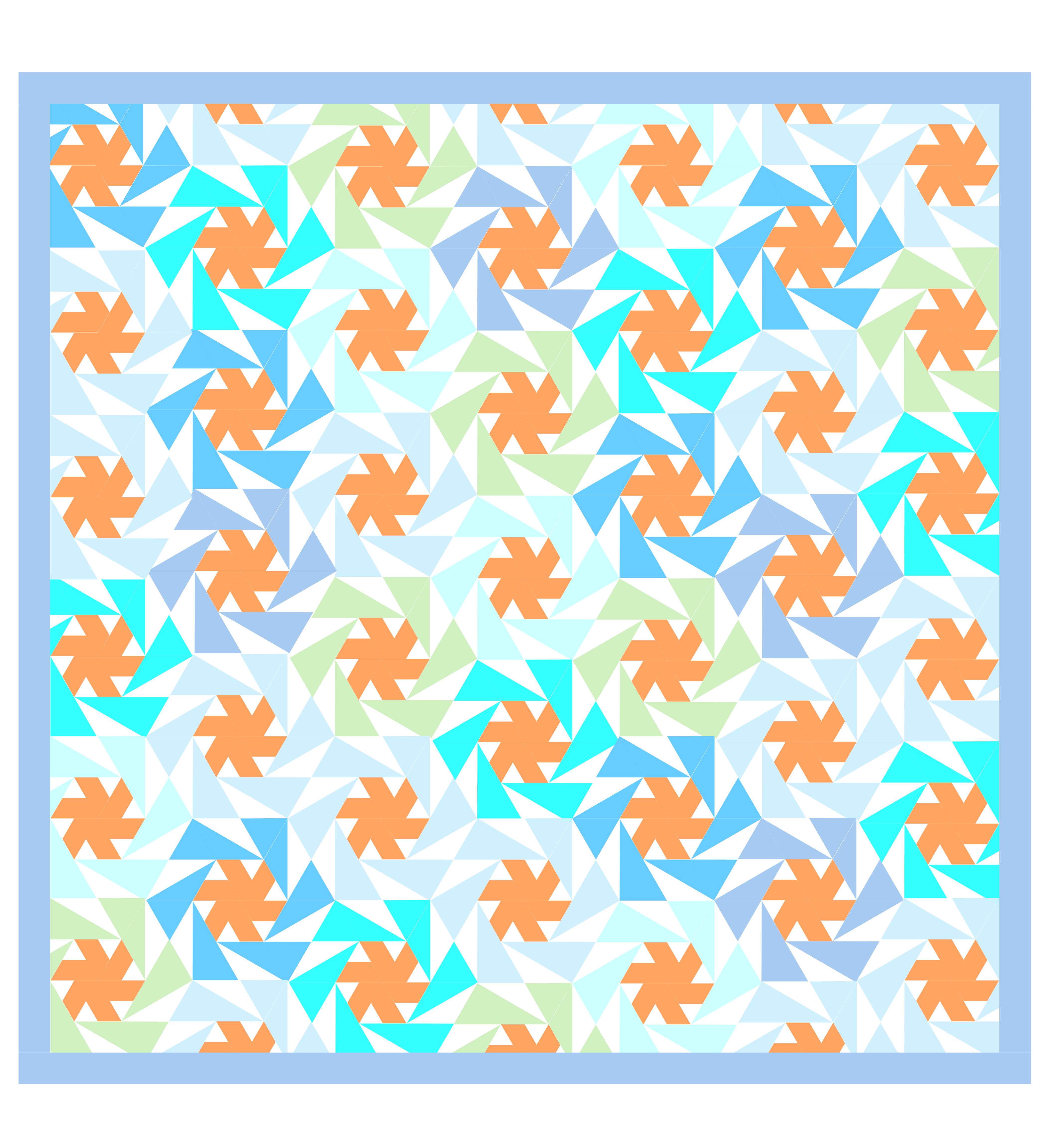
Antique Field of Diamonds Quilt Drafted in EQ7
Click here to go straight to English
De november 2012 Club EQ Challenge was heel simpel: Gebruik de LineBrush Tool in je quiltontwerp. Dit gereedschap is erg handig en snel om een One Patch Quilt in te kleuren. Je trekt het penseel in een rechte lijn over meerdere lapjes, en die kleurt EQ dan allemaal tegelijk in.
Op internet vond ik een foto van een spectaculaire antieke quilt, gemaakt met allemaal kleine zeshoekjes: http://cindysantiquequilts.com/dynapage/IP474.htm Ik heb hem voor deze challenge nagetekend.
Daarna ben ik gaan variëren met andere kleuren voor de oranje, groene en witte randen. Als je een quiltontwerp eenmaal in EQ7 hebt staan kun je er van alles mee uitproberen; andere kleuren, een andere rand, ander formaat.

Variatie met Gestippelde Oranje Lijnen en een Groene Rand
Dit patroon kun je natuurlijk maken met Inklingo hexagons in elke gewenste maat. Als je deze quilt maakt met de nieuwste Inklingo hexagoncollectie, met zijden van 0,625 inch [bijna 1,6 cm.] wordt het binnendeel (zonder rand) circa 79 bij 91 inch [ca. 201 x 231 cm.]. De antieke quilt meet 81 x 91 inch [ca. 206 cm x 231 cm].
Je kunt in EQ heel snel zien hoeveel hexagons je moet printen per kleur, doordat EQ het aantal ‘patches’ per stof aangeeft bij de berekening van de benodigde hoeveelheid stof. (‘Print Yardage’). Ik geef hier de aantallen hexagons en stofmetrage voor deze quilt met 0,625 inch Inklingo zeshoeken.
Het aantal witte hexagons in de quilt bovenaan deze post is 3308. EQ rekent hier natuurlijk ook de kleine witte lapjes mee die aan de boven- en onderkant van de quilt zitten. Dat zijn geen hele hexagons, maar ik zou er voor het gemak hele voor nemen en de quilt voor het aanzetten van de randen recht bijsnijden.

Field of Diamonds variatie met Groen vervangen door Zwart
Voor ‘Print Yardage’ heb ik de stofbreedte ingesteld op 44 inch [112 cm.] breed (dezelfde breedte als waar Inklingo mee rekent) en met een kwart inch [6 mm.] naadtoeslag. Dan geeft EQ aan dat ik 6 + 1/8 yard witte stof nodig heb.
Ik heb dit vergeleken met de benodigde hoeveelheid stof volgens Inklingo. Deze kun je zelf berekenen met de informatie onder ‘suggested custom sizes’ in elke Inklingo-collectie.
Volgens deze informatie in de Inklingo .625 Hexagon collectie kun je, als de stof netjes recht is gesneden etc., 450 hexagons uit een yard stof halen met de layout voor een rolmes. Als je nieuwe stof koopt, moet je ook nog rekening houden met 3-5% krimp tijdens het voorwassen. Dan heb je minimaal 7,5 yard [ca. 6.85 m] stof nodig.
Met de layout voor knippen met een schaar kun je 495 hexagons uit een yard stof halen en houd je een strookje over aan de zijkanten, dus dan heb je iets minder nodig. Maar ja, wie heeft er zin om duizenden van die kleine zeshoeken met de schaar te knippen?

De ingezonden quiltvariatie, met grijs en zwart, in plaats van oranje en groen
Omdat ik weet hoe ontzettend efficiënt Inklingo de stof benut, geeft dit mij aan dat de door EQ7 opgegeven hoeveelheid stof krap kan zijn. (EQ rekent hier natuurlijk niet met 3308 volledige hexagons, en ook niet met krimp).
EQ heeft de naam de hoeveelheid stof juist ruim op te geven, en dit was in oudere versies (t/m EQ5) ook echt het geval, maar dat is veranderd sinds EQ6! Dat is de reden dat, als ik stof moet kopen voor een ontwerp in EQ7, ik mijn stofbreedte normaal op 40 inch instel, en voor bijv. foundation piecing ook de breedte voor de seam allowance ruim instel. Ik koop liever te veel stof dan te weinig!

De pastelkleurige ruiten zijn ongewijzigd, maar het wit is vervangen door zwart
O ja, er zijn 1572 groene hexagons (3,7 yard stof nodig of 3,37 m.)
En je hebt 1173 oranje hexagons nodig (2,75 yard stof of 2,51 meter). Voor de oranje randen moet je nog extra stof rekenen!
Voor de pastelkleurige ruiten kun je natuurlijk net zo veel verschillende stoffen gebruiken als je wilt, in allemaal kleine hoeveelheden. De binnenste ruit is gemaakt van 8 zeshoeken, en de ring eromheen van 16.
XXX Annika
ENGLISH

Antique Field of Diamonds Quilt Drafted in EQ7
The November 2012 Club EQ Challenge was very simple: Use the LineBrush Tool in your quilt design. This tool is very handy and quick to color a One Patch Quilt. You draw the brush in a straight line over several patches, and EQ colors them all at once.
On the internet I found a picture of a stunning antique quilt, made from lots of small hexagons: http://cindysantiquequilts.com/dynapage/IP474.htm I drafted it for this challenge.
Then I designed variations with swapping the orange, green and white rows and borders for different colors. Once you have a design in EQ7, you can try all kinds of variations very quickly; swap colors, a different border, different sizes.

Variation with Orange Lines Dotted and Green Border
Of course you can make this pattern with Inklingo hexagons in any size. If you make it with the most recent Inklingo hexagon shape collection, with 0.625 inch sides, the quilt center (without the borders) will be ca. 79 x 91 inches.
The antique quilt measures 81 x 91 inches.
EQ can show you very quickly how many hexagons you need to print of each color, by giving you the number of patches from each fabric, if you choose ‘Print Yardage’. I will give you the numbers of hexagons to print for this quilt, and yardage estimates for a quilt with 0.625″ hexagons.
The number of white hexagons in the quilt at the top of this post is 3308. EQ takes the small white patches at the top and bottom edges into account. Those are not whole hexagons, but for ease, I would just print and sew whole hexagons, and trim the edges of the quilt straight before adding the borders.

Field of Diamonds with Green Replaced by Black
I adjusted the settings for Print Yardage to 44 inches for width of fabric, the same width Inklingo uses for calculations of numbers of shapes from yardage, and seam allowance set to a quarter inch. EQ7 tells me I need 6 +1/8 yard of white fabric.
I compared this with the yardage according to Inklingo. You can calculate this yourself, with the information provided under ‘suggested custom sizes’ in each Inklingo Collection of Shapes.
According to the info in the 0.625 hexagon collection, you can get 450 hexagons in the layout for rotary cutting, from a yard of fabric, if the fabric is cut straight (it is a tight fit). If you buy new fabric, you have to take shrinkage into account (3-5%) that occurs during the first washing. That makes a minimum of 7.5 yard of fabric.
With the layout for cutting with scissors you can get 495 hexagons from a yard of fabric, and there will a strip left on the sides, so you need a little less fabric. But who wants to cut thousands of small hexagons with scissors?

The quilt variation I entered, with gray and black replacing orange and green
Because I know how very economic Inklingo uses fabric, this tells me that yardage calculations from EQ can be tight. (EQ does not calculate with 3308 whole hexagons, nor does it calculate extra for shrinkage).
EQ has a reputation for calculating too much yardage. This was true for previous versions (up to and including EQ5), but that has changed since EQ6!
That’s the reason why, if I have to buy fabric for a design in EQ7, I usually set my fabric width to 40 inches, and if it is for foundation piecing, I also set my seam allowance quite wide. I would rather buy extra than ending up with not enough fabric.

The pastel diamonds are unchanged, but the white is replaced by blue
And o yes, there are 1572 green hexagons (3.7 yards of fabric).
And you need 1173 orange hexagons (2.75 yards of fabric). Remember that you have to add yardage for the orange borders!
For the pastel colored diamonds you can use as many different fabrics as you like, in small amounts. The center diamond is made of eight hexagons, and the ring around it has 16 hexagons.
XXX Annika














 Het ontwerp is geïnspireerd op
Het ontwerp is geïnspireerd op 



